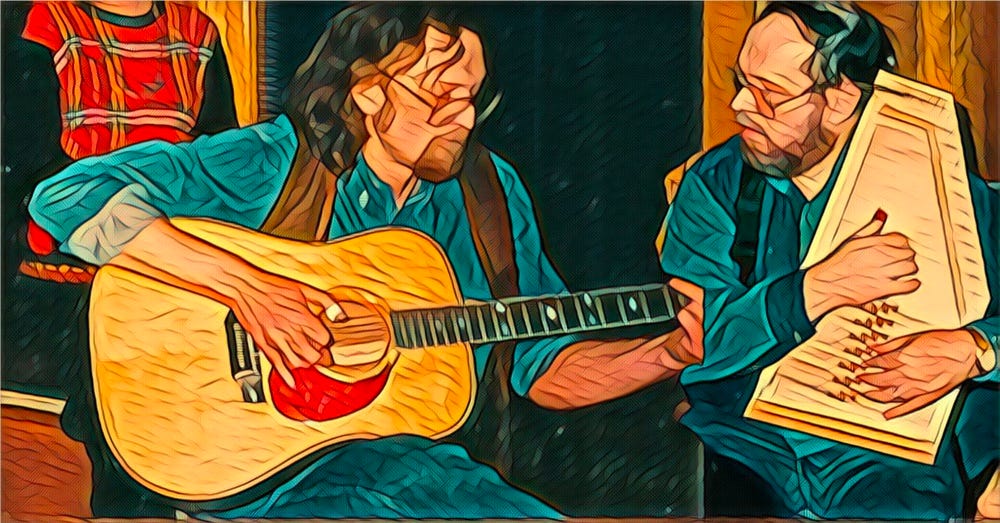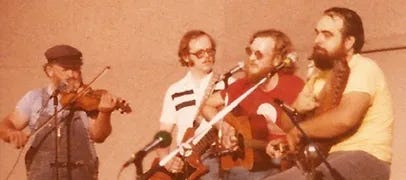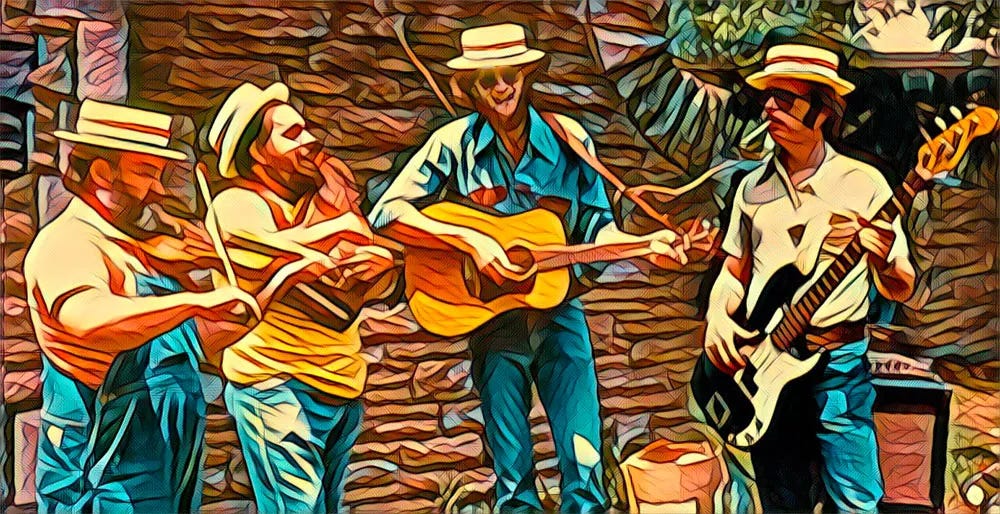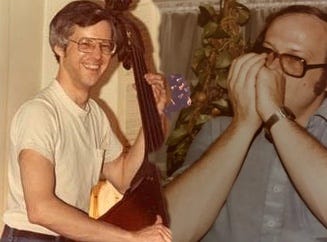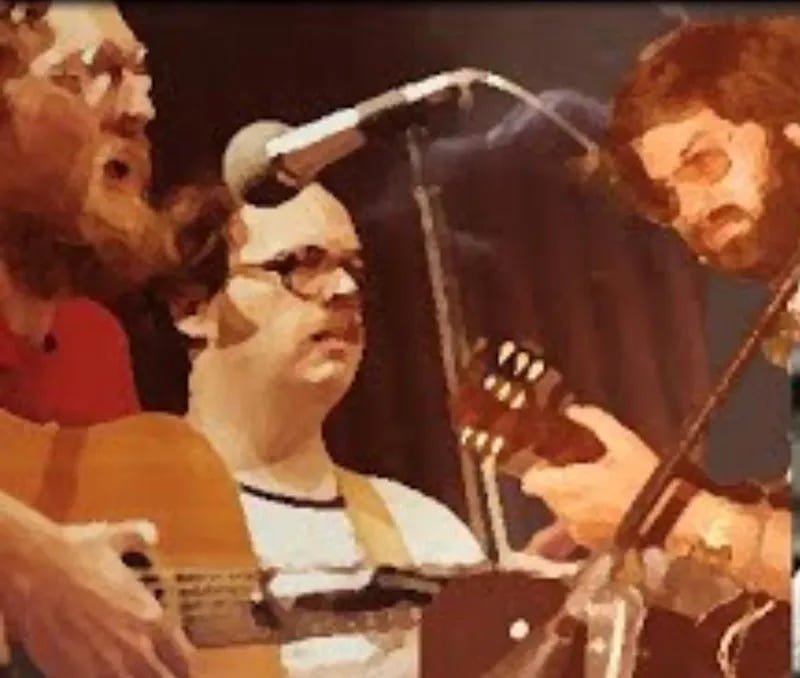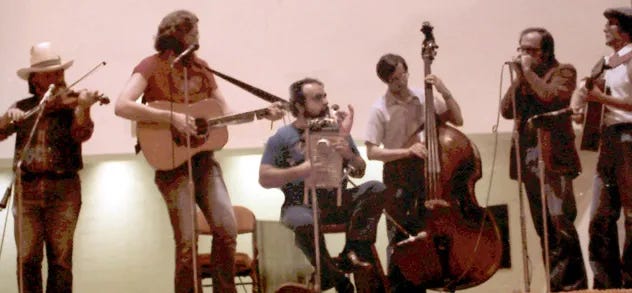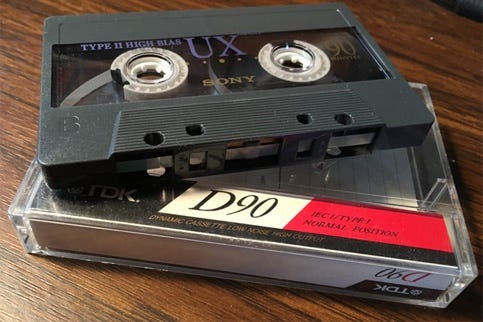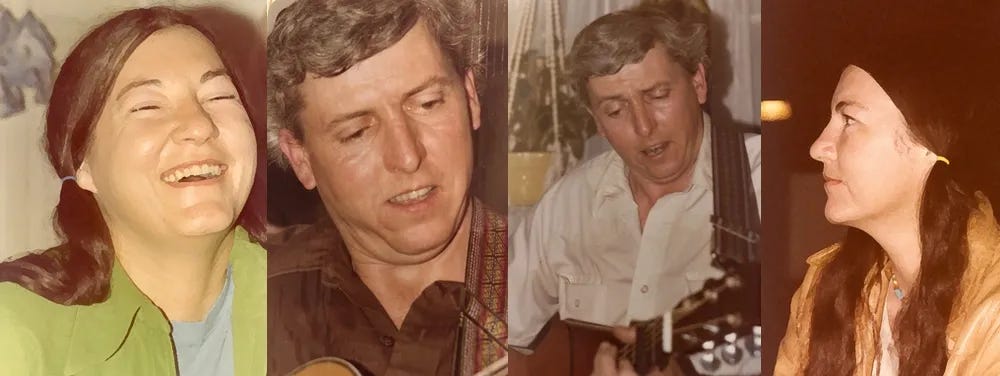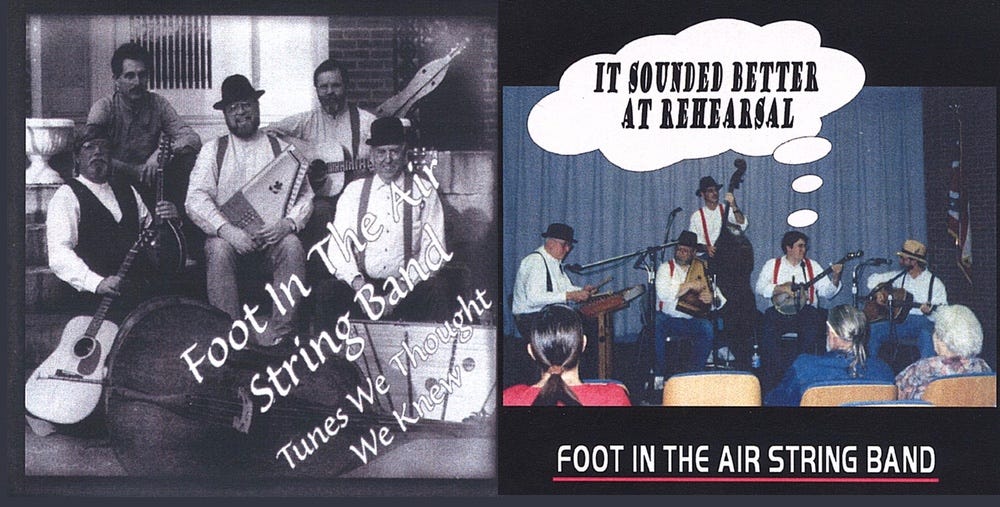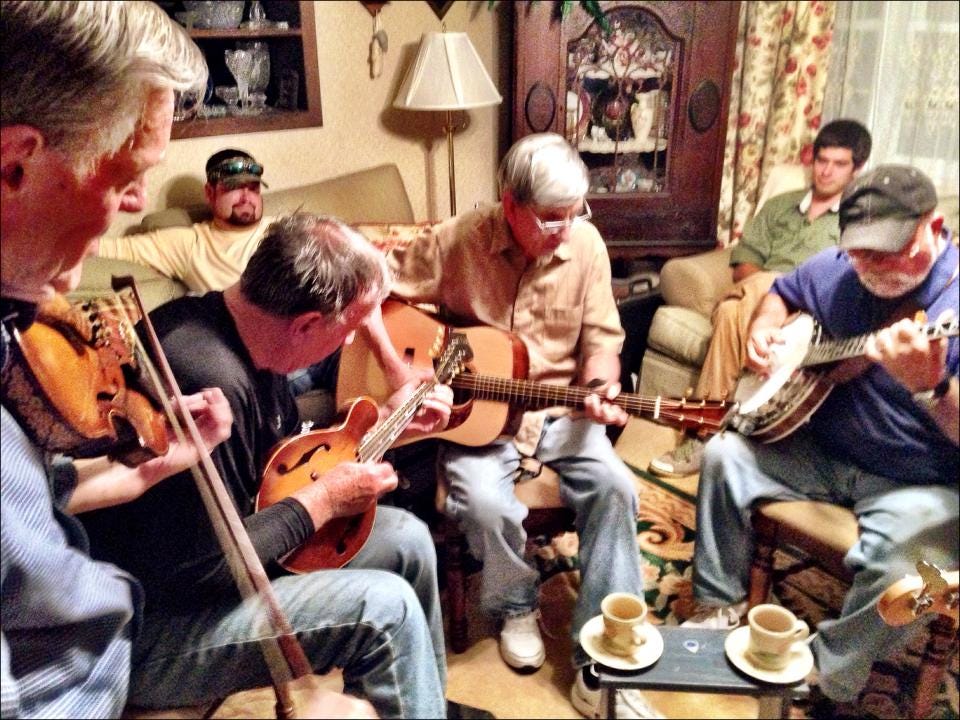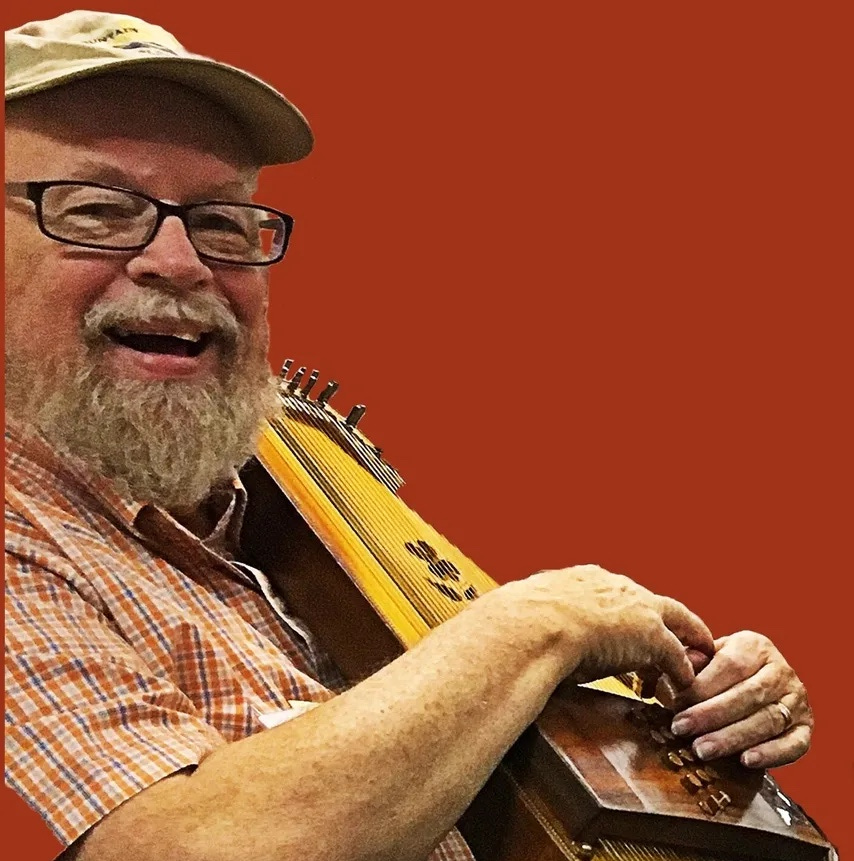The Multi-Talented Mr. Schneider
#330 / Flood Time Capsule: 1996
When Stewart Schneider and Charlie Bowen sat down 28 years ago this week to record some new tunes they had worked out, it was just the latest episode in a very long musical partnership.
The two had been making music together ever since they met in the trumpet section of the Ashland, Ky., high school band in the mid-1960s. From there they moved on to the world of folk music, learning from each other with their first guitars.
Several years after that, when Charlie teamed with Dave Peyton to form The Flood, it was only natural that Stew would be part of the mix.
In fact, when fiddler Joe Dobbs joined up in 1975, Schneider already was a veteran Floodster, having been at the table for more than a year, bringing assorted instruments to back Charlie and Dave’s vocals and Roger Samples’ guitar.
By the time of the band’s first big public gig at the bicentennial community picnic in Ritter Park on July 4, 1976, Stew was playing bass with the group.
He’d still be serving as the band’s first bassist later when the guys got juggy with it and started exploring those dandy after-dark hokum tunes of folks like The Memphis Jug Band, Gus Cannon’s Jug Stompers and Tampa Red and Georgia Tom.
Then on down the road, when Bill Hoke came along to play upright bass with the group, Stew switched to a bluesy harmonica to be The Flood’s first woodwind section.
The Front Royal Years
Stewart also was central to The Flood story in the fall of 1976 when the band’s first spin-off group was born.
It came about during a time when The Flood was at a low tide, because for assorted reasons, the band member suddenly found themselves with little time to be together.
Joe was busy setting up his new Fret ’n Fiddle music store; Rog was busy being a newlywed, having married his second wife, Linda Camp, the previous March; Dave was busy getting back into the work-a-day world of the newspaper after his year’s sabbatical with the Alicia Paterson grant.
As a result, Stew and Charlie took their musical needs and urges elsewhere, teaming up with a new friend. Singer-songwriter John Koenig was one of Bowen’s fellow staffers at The Huntington Advertiser, and he joined with Stew and Charlie to form a trio they called Front Royal.
That innovative group inspired Schneider to explore more intricate bass lines to fit Koenig’s sophisticated melodies and to join Charlie and John to craft harmonies for Bowen’s lyrics. Want a sample of the 1977 version of Stewart Schneider? Here’s a bit of his bass work on this little Front Royal riff called “Rappin’”:
For the rest of the decade, Charlie and Stew divided their time between The Flood and Front Royal, each of which often performed at the biennial “Bowen Bashes” from 1977 to 1980.
Front Royal lasted only about four year, ending when John moved away with his new wife, Barbara, to pursue job opportunities.
Its demise coincided with a near-decade-long drought in Floodishness (a dry spell that finally relented in the 1990s). As reported earlier, for most of founding members of The Flood, the 1980s meant a bit of a retreat from music as they took up the obligations of family and of making a livelihood.
Enter the Autoharp
During that hiatus, Stew drifted toward another new instrument, becomeing quite a talented and tasteful Autoharp player, as he would soon demonstrate at the Bash reunion in the fall of 1991.
Building on the fun they had at that particular party at the Peytons’ Place, Charlie and Stew were soon jamming together weekly at the Bowen House, exploring a lot of new music.
Here’s a sample. Twenty-eight years ago this week, the two of them turned on a recorder to preserve a few tunes:
The first song on the track is a composition by Andy M. Stewart and Manus Lunny callled “My Heart Belongs to She,” followed by an instrumental that Stewart himself wrote. (We’ve forgotten what he called it, so it goes down in Flood history simply as “Stewart’s Song.”)
The final cut is the guys’ rendition of the Irish lullaby, “October Wind,” featuring not only Stew’s harmonica, but also his vocal harmony. (And there's the evidence; don’t let him ever tell you he can’t sing….)
The Toothman Party
At about this time came the event that we have called “the party that re-birthed the band.” As reported earlier, that was the winter gathering at Cathie and Bob Toothman’s Ironton, Ohio, home at which Joe Dobbs suddenly reunited with Dave and Charlie, inspiring them to start bringing the band back to life.
As it turned out, the same party also was important for Stew Schneider, enabling he to make connections that changed the direction of his musical life as well. Soon after the party, Stew was being courted by Bob Toothman to bring his mad Autoharp chops for a band he was creating.
Foot in the Air String Band, devoted to traditional Appalachian music, became one of the Tri-State Area’s premiere old-time groups.
Between 1998 and 2004, Toothman and Schneider — along with Charlie Cook, Ken Castania, Jim Miller and others — released two albums that were highly regarded, despite their self-deprecating titles (“Tunes We Thought We Knew” and “Sounded Better at Rehearsal”).
They stayed loyal to the code they laid out on the liner notes for their first album:
Foot in the Air is an authentic Appalachian band staffed by authentic Appalachians. We grew up at the meeting of Ohio, West Virginia, and Kentucky, listening to the music of JP Fraley, 'Big Foot' Keeton, and the Saturday Night Jamboree. FITA tries to be as true to the music we grew up with as we can be, without trying to turn it into a museum piece. We add our own spin to each tune. All our music is from the acoustic old time tradition. We do not play no rock and roll.
Bringing Stew Back into the Floodstream
It lasted for about a decade. In September 2007, The Flood’s extended musical family was saddened and stunned by Bob Toothman’s death.
After Bob was gone, Foot in the Air deactivated, and Stew’s musical activity went into decline. This development was viewed with alarms by those of us who have always admired Schneider’s tasteful approach to the Autoharp.
That’s why in the spring of 2010, Doug — who in his pre-Flood days used to sit with Foot in the Air — proposed a kind of musical outreach program. His idea was to start a Monday night picking session at the Chaffin house to which he and Charlie could drew Schneider in.
It worked. “We had a great little evening of music last night,” Charlie told his cousin Kathy in an email the next day. “I got to Doug's about 7 and Stewart came about 10 minutes later and we played for the next 2 1/2 hours. Good times.”
Stew was a little rusty, he added, “but there were some real good moments and we're going to do it again next week. I'd really like for this to become a regular thing.”
It certainly did. Monday nights at Doug and Donna’s became a beloved weekly event for the next seven or eight years. Here from May 2012 is a gorgeous sample. It’ s the Monday night group’s playing of a tune that Stewart himself brought to the evenings, the Phil Cunningham composition called “Miss Rowan Davies”:
Meanwhile, word of Monday nights at the Chaffin house got out, and Doug, Stew and Charlie often were joined by friends like George Fliehman and Glenn Perkins, Randy Hamilton, Rick Harmon and Danny Gillum.
The Monday night fun even carried over to the annual Fraley Festival. For instance, the original Monday night regulars took the Fraley stage in 2018 as shown in the above picture preserved by our old friend Barb Kuhn.
Speechless
After all that, it was only natural to invite Stew to be the guest artist on the next Flood album. Four months after the Fraley performance pictured above, Stewart accompanied Charlie, Doug, Randy and Sam St. Clair up to Paul Martin’s hilltop studio for an afternoon of recording in one of the sessions that would result in the band’s Speechless album.
As reported earlier, Schneider was featured on three or four tunes on the album, including this one, his signature tune, “Carrickfergus”:


